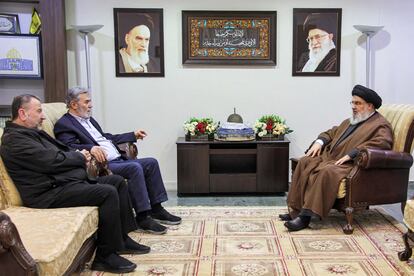Sinwar, Haniyeh, Nasrallah: Who are the Hezbollah and Hamas leaders eliminated by Israel?
Over the past year, Israel has killed nearly all of the Palestinian and Lebanese militia leaders it had set its sights on

Following the October 7, 2023, Hamas attacks that triggered the Gaza war and escalated violence in the Middle East, Israel has sought to eliminate the top leaders of both Hamas and Hezbollah, the Lebanese Shiite militia-party that supports the former. The assassination of Yahya Sinwar, Hamas’s top leader, announced on Thursday, is the latest in a series of “targeted operations” — the term used by the Israel Defense Forces (IDF) — and bombings that have also resulted in the deaths of thousands of civilians. These operations have led to the liquidation of at least three senior Palestinian officials and nine Lebanese individuals over the past year.
Among the most prominent figures are Ismail Haniyeh, the former top Palestinian political leader, and Hassan Nasrallah, the Shiite cleric who has led Hezbollah for 32 years. Despite the casualties, both groups maintain that the killings do not pose a threat to their existence or the continuity of their operations. The only death that has not been confirmed by all parties is that of Mohamed Deif, considered the head of Hamas’s armed wing and the organization’s number two man, just behind Sinwar. Israel claims to have killed him, but Hamas denies this.
Below is a list of the top leaders killed by Israel since the onset of a conflict that has so far claimed at least 1,200 lives in Israel, over 42,000 in Gaza, and more than 2,300 in Lebanon.
Hamas leaders
Ismail Haniyeh. Hamas’s top political leader was assassinated on July 13 in Tehran while attending the inauguration of Iran’s new president, Masoud Pezeshkian. Although Israel did not officially claim responsibility for the attack, few hesitated to point to its foreign intelligence agency, the Mossad. Unlike other leaders of the fundamentalist militia, Haniyeh did not live in hiding; he primarily resided in Qatar, where he actively participated in various events. He was responsible for the group’s foreign relations and took part in negotiations for a ceasefire that ultimately was not reached. He had survived other attacks and had spent time in Israeli prisons.
Haniyeh was regarded as a pragmatist willing to accept Israel’s existence de facto if a peace agreement resulted in the establishment of a Palestinian state along the borders that existed prior to the 1967 Six-Day War, although he consistently rejected formal recognition. Over time, he adopted a more hardline stance and praised the attacks of October 7. His death at the age of 62 in a military residence in Tehran dealt a significant blow to Hamas and was viewed as an affront to the Iranian regime, which responded on October 1 by launching nearly 200 missiles at Israel.
Saleh al-Aruri. He was a co-founder of the Ezzedeen Al-Qassam Brigades, the armed wing of Hamas, and until his death was regarded as the Palestinian militia’s chief negotiator, a role he assumed in 1980. Throughout his militancy, he led negotiations with various Palestinian factions, Israeli authorities, and international allies, and he was one of the main financial officials within the organization. An explosion in the Beirut neighborhood of Dahieh claimed his life on January 2. Hamas immediately accused Israel of the attack, but Benjamin Netanyahu’s government has yet to acknowledge responsibility.
The attack that killed al-Aruri, 57, marked the first Israeli operation against the Lebanese capital since 2006. According to Reuters, a missile launched from a drone resulted in his death, along with two other leaders of the group’s armed wing. Al-Aruri was also seen as a loose cannon within Hamas, having ordered armed actions independently without consulting the rest of the leadership.

Mohammed Deif. He is — or was — the commander-in-chief of the Ezzedeen Al-Qassam Brigades and the No. 2 in the Palestinian militia in the Gaza Strip, following only its leader, Yahya Sinwar. The circumstances surrounding Deif’s death remain unclear; the Israeli army confirmed it in August after airstrikes targeted the Khan Yunis area in Gaza, following intelligence assessments that indicated the strikes had resulted in the deaths of another 90 people. However, Hamas denies this claim. Since 2001, Deif has survived numerous assassination attempts by Israel and has been declared dead multiple times, only to have those declarations retracted later. According to Israeli sources, he is considered one of the masterminds behind the October 7 Hamas attacks against southern Israel, which triggered the Gaza war and the subsequent escalation of violence in the Middle East.
Marwan Issa. On March 18, the IDF announced the death of Marwan Issa, regarded as another mastermind behind the October 7 attacks, although the Palestinian militia has not officially commented on the matter. He was one of the most prominent leaders in Hamas, serving as the deputy commander of the militia’s military wing. Both Issa, 58, and another senior Hamas official were killed in an airstrike in central Gaza, despite being in an underground compound. Issa had been Mohamed Deif’s deputy since 2012 and was a member of both the militia’s military council and its political office in Gaza, which is overseen by Yahya Sinwar, according to The New York Times. He was considered a skilled strategist who played a crucial role as a liaison between Hamas’s military and political leaders.
Hezbollah leaders
Hassan Nasrallah. Hezbollah confirmed the death of Hassan Nasrallah, 64, on September 28. Nasrallah — Hezbollah’s top leader for 32 years and the public face of the Lebanese militia-party — was killed in an Israeli airstrike that targeted a residential area in the Beirut neighborhood of Dahieh. “During Hassan Nasrallah’s 32-year reign as the Secretary-General of Hezbollah, he was responsible for the murder of many Israeli civilians and soldiers, and the planning and execution of thousands of terrorist activities,” said an Israeli military statement. “He was responsible for directing and executing terrorist attacks around the world in which civilians of various nationalities were murdered. Nasrallah was the central decision-maker and the strategic leader of the organization.” Hugely popular within the Shiite community, Nasrallah was also the leader who successfully elevated Hezbollah into the political arena.
Ibrahim Qubaisi. An Israeli airstrike on an apartment building in Dahieh on September 24 resulted in the death of this Hezbollah commander. A member since 1980, Qubaisi commanded several units within the militia’s missile and rocket division, including the precision-guided missile division. Previously, he held a senior position in the operations division, according to the IDF. “Qubaisi was a central source of knowledge in the field of missiles, and was close to the senior military leadership of Hezbollah,” the IDF stated. Other high-ranking officers were also casualties of the strike that killed this commander.
Ibrahim Aqil. On September 21, Israel announced the death of Ibrahim Aqil, the head of the elite Radwan Force. He was killed in a twin-missile attack in Dahieh that also claimed the lives of at least 13 other people and wounded 66. Both the Israeli military and Hezbollah confirmed his death.
Ahmed Wabi. Another prominent commander of the elite Radwan forces, Wabi was killed in the same missile attack that took Ibrahim Aqil’s life. He led operations on the Lebanese front during the initial months of the Gaza war.

Fuad Shukr. A long-time member of the Lebanese militia and responsible for military activities, Shukr was killed in a “targeted attack” on a Hezbollah headquarters in Dahieh on July 30. Israel regarded him as the right-hand man of Hassan Nasrallah, the head of the Shiite group. The Israeli operation that resulted in his death was a response to the deaths of 12 minors a few days earlier in a missile attack in the Syrian Golan Heights, which is occupied by Israel. The IDF attributed this attack to Hezbollah, although the militia denied involvement. The U.S. State Department also accused him of directing an attack on a barracks in Lebanon in 1983 that killed 241 Americans.
Mohammed Nasser. An Israeli strike in Tyre, Lebanon, killed a senior Hezbollah commander on July 3, according to two Lebanese security sources and a statement from the militia, which identified him as Mohammed Nasser without providing further details. The security sources described him as one of Hezbollah’s most senior figures and said that he was responsible for a section of the militia’s operations along the border with Israel.
Taleb Abdallah. Hezbollah’s field commander was killed on June 12 in a strike attributed to Israel, which claimed it had targeted a command and control center in southern Lebanon. Abdallah, who was responsible for the central region of the southern border, held the same rank as Mohammed Nasser. His death marked the highest-ranking casualty suffered by Hezbollah in the eight months of fighting that had taken place up to that point. In response to his killing, the Shiite militia vowed to increase the intensity, strength, and frequency of its attacks. The following day, they fulfilled that threat with their largest rocket offensive — launching 215 rockets against northern Israel — which reached further into Israeli territory (37 miles) than any prior strike since the beginning of hostilities.
Wissam al-Tawil. An Israeli strike killed Wissam al-Tawil, the deputy head of a unit within Hezbollah’s elite Redwan force, on January 8. Al-Tawil was the highest-ranking Hezbollah leader to be killed by Israel since the Shiite militia-party opened a Lebanese front against Israel in October in support of its ally, Hamas. He was killed when his car was struck by an Israeli shell in Khirbet Selm, located about six miles north of Lebanon’s border with Israel.
Suhail Hussein Husseini. Hezbollah’s logistics and budget chief was killed in an airstrike on Dahieh on October 8, according to Israel. Hezbollah has neither confirmed nor denied the report.
Sign up for our weekly newsletter to get more English-language news coverage from EL PAÍS USA Edition
Tu suscripción se está usando en otro dispositivo
¿Quieres añadir otro usuario a tu suscripción?
Si continúas leyendo en este dispositivo, no se podrá leer en el otro.
FlechaTu suscripción se está usando en otro dispositivo y solo puedes acceder a EL PAÍS desde un dispositivo a la vez.
Si quieres compartir tu cuenta, cambia tu suscripción a la modalidad Premium, así podrás añadir otro usuario. Cada uno accederá con su propia cuenta de email, lo que os permitirá personalizar vuestra experiencia en EL PAÍS.
¿Tienes una suscripción de empresa? Accede aquí para contratar más cuentas.
En el caso de no saber quién está usando tu cuenta, te recomendamos cambiar tu contraseña aquí.
Si decides continuar compartiendo tu cuenta, este mensaje se mostrará en tu dispositivo y en el de la otra persona que está usando tu cuenta de forma indefinida, afectando a tu experiencia de lectura. Puedes consultar aquí los términos y condiciones de la suscripción digital.
More information
Archived In
Últimas noticias
Most viewed
- Reinhard Genzel, Nobel laureate in physics: ‘One-minute videos will never give you the truth’
- Oona Chaplin: ‘I told James Cameron that I was living in a treehouse and starting a permaculture project with a friend’
- Pablo Escobar’s hippos: A serious environmental problem, 40 years on
- Chevy Chase, the beloved comedian who was a monster off camera: ‘Not everyone hated him, just the people who’ve worked with him’
- Why we lost the habit of sleeping in two segments and how that changed our sense of time










































